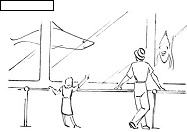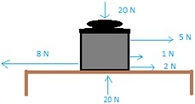1. The water in the plumbing in a house is at a gauge pressure of 240,000 Pa. What force does this cause on the top of the tank inside a water heater if the area of the top is 0.7 m2? (Ignore atmospheric pressure.)
2. A viewing window on the side of a large tank at a public aquarium measures 55 in. by 60 in. The average gauge pressure from the water is 7 psi. What is the total outward force on the window?

3. A small statue is recovered in an archaeological dig. Its weight is measured to be 2.1 lb and its volume 0.06 ft3.
(a) What is the statue's weight density?
(b) What substance is it, most likely?
silver juniper wood lead
brass iron
Show My Work (Optional)
4.
A certain part of an aircraft engine has a volume of 2.1 ft3.
(a) Find the weight of the piece when it is made of copper.
(b) If the same piece is made of aluminum, what is its weight?
Determine how much weight is saved by using aluminum instead of copper.
5.
The depth of the Pacific Ocean in the Mariana Trench is 36,198 ft. What is the gauge pressure at this depth?
6.
A storage tank 23 m high is filled with pure water. (Assume the tank is open and exposed to the atmosphere at the top.)
(a) Find the gauge pressure at the bottom of the tank.
(b) Calculate the magnitude of the force produced by the fluid that acts on a square access hatch at the bottom of the tank that measures
0.7 m by 0.7 m.
7.
A modernday zeppelin holds 7,500 m3 of helium. Compute its maximum payload at sea level. (Assume the helium and air to be at 0°C and 1 atm.)
8.
A juniperwood plank measuring 0.16 ft by 1 ft by 14 ft is totally submerged in water.
(a) What is its weight?
(b) What is the buoyant force acting on it?
(c) What is the size and the direction of the net force on it? size direction
Show My Work (Optional)
9.
A rectangular block of ice with dimensions 2 m by 2 m by 0.2 m floats on water. A person weighing 990 N wants to stand on the ice. Would the ice sink below the surface of the water?
10.
The wing of an airplane has an average crosssectional area of 14 m2 and experiences a lift force of 88,000 N. What is the average difference in the air pressure (in N/m^2)between the top and bottom of the wing?
11.
Describe the four phases of matter. Compare their external, observable properties.
Solids: (Select all that apply.)
are generally good conductors of electricity and interact strongly with magnetic fields
can be compressed or squeezed into a smaller volume readily
flow readily, conforming to the shape of their container have a welldefined boundary or surface
are rigid, and generally retain their shape unless distorted by a force
Liquids: (Select all that apply.)
are generally good conductors of electricity and interact strongly with magnetic fields
can be compressed or squeezed into a smaller volume readily
flow readily, conforming to the shape of their container have a welldefined boundary or surface
are rigid, and generally retain their shape unless distorted by a force
Gases: (Select all that apply.)
are generally good conductors of electricity and interact strongly with magnetic fields
can be compressed or squeezed into a smaller volume readily
flow readily, conforming to the shape of their container
have a welldefined boundary or surface
are rigid, and generally retain their shape unless distorted by a force
Plasmas: (Select all that apply.)
are generally good conductors of electricity and interact strongly with magnetic fields
can be compressed or squeezed into a smaller volume readily
flow readily, conforming to the shape of their container
have a welldefined boundary or surface
are rigid, and generally retain their shape unless distorted by a force
Compare the nature of the forces between atoms or molecules (or both) in the solid, liquid, and gas phases.
Solids:
The attractive forces bind particles together, but not rigidly so; each atom or molecule can move about relative to the others but is always in contact with other atoms or molecules.
The attractive forces between particles are too weak to bind them together; atoms or molecules move about freely with high speed and are widely separated, only coming into contact when they collide.
The attractive forces are so strong that the atoms or molecules are rigidly bound to their neighbors and can only vibrate.
Liquids:
The attractive forces bind particles together, but not rigidly so; each atom or molecule can move about relative to the others but is always in contact with other atoms or molecules.
The attractive forces between particles are too weak to bind them together; atoms or molecules move about freely with high speed and are widely separated, only coming into contact when they collide.
The attractive forces are so strong that the atoms or molecules are rigidly bound to their neighbors and can only vibrate.
Gases:
The attractive forces bind particles together, but not rigidly so; each atom or molecule can move about relative to the others but is always in contact with other atoms or molecules.
The attractive forces between particles are too weak to bind them together; atoms or molecules move about freely with high speed and are widely separated, only coming into contact when they collide.
The attractive forces are so strong that the atoms or molecules are rigidly bound to their neighbors and can only vibrate.
12.
Why is it that a person can lay still on a "bed" of nails (see the figure below) without suffering any serious injuries but would incur severe puncture wounds to his feet if he tried to stand barefoot on the same "bed"?

The weight of a person lying still on a "bed" of nails is much less than the weight of a standing person, and so the pressure (force/unit area) on the person's skin is much less when lying down. Because the pressure is much less when lying down, the nails do not puncture the skin.
A person lying still on a "bed" of nails has his weight distributed over a much larger area than if he were standing, and so the force (pressure unit area) on the person's skin is much greater when lying down. Because the upward force is much greater when lying down, the net force (weight - force from nails) is closer to zero, and the nails do not puncture the skin.
A person lying still on a "bed" of nails takes up far more volume than a standing person, and so the buoyant force exerted by the air is much greater on a lying person than a standing person. Because the net force (weight - buoyant force) is much less, the pressure (force/unit area) is much less for a lying person, and the nails do not puncture the skin.
A person lying still on a "bed" of nails has his weight distributed over a much larger area than if he were standing, and so the pressure (force/unit area) on the person's skin is much less when lying down. Because the pressure is much less when lying down, the nails do not puncture the skin.
13.
Would the weight density of water be different on the Moon than it is on Earth?
Yes
No
What about the mass density?
The mass density would stay the same.
The mass density would not stay the same.
14.
The pressure in the air along the upper surface of an aircraft's wing (in flight) is lower than the pressure along the lower surface. Compare the speed of the air flowing over the wing to that of the air flowing under the wing.